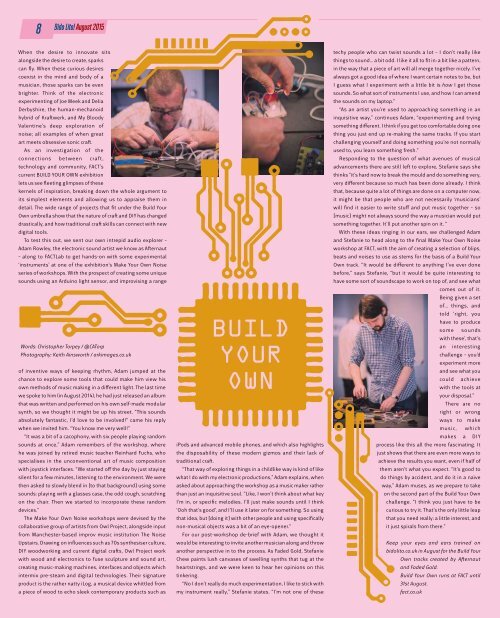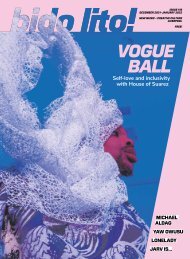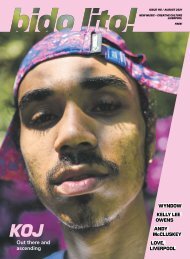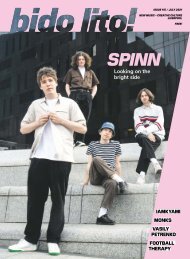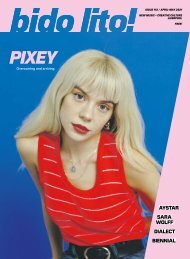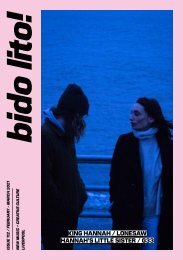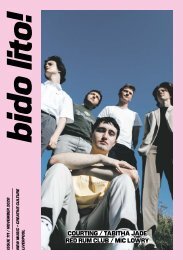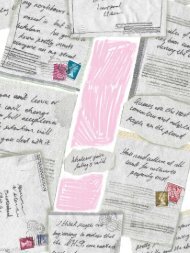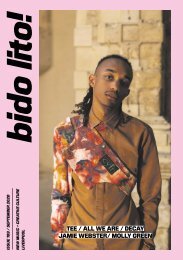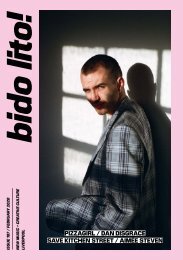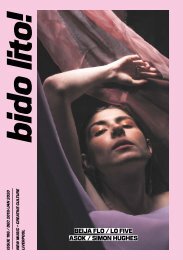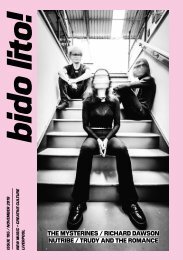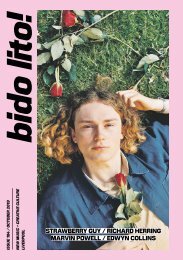Issue 58 / August 2015
August 2015 issue of Bido Lito! Featuring MALIK AND THE O.G'S, MARVIN POWELL, AVIATOR, MUSIC MIGRATIONS, LIMF 2015 PREVIEW and much more.
August 2015 issue of Bido Lito! Featuring MALIK AND THE O.G'S, MARVIN POWELL, AVIATOR, MUSIC MIGRATIONS, LIMF 2015 PREVIEW and much more.
Create successful ePaper yourself
Turn your PDF publications into a flip-book with our unique Google optimized e-Paper software.
8<br />
Bido Lito! <strong>August</strong> <strong>2015</strong><br />
When the desire to innovate sits<br />
alongside the desire to create, sparks<br />
can fly. When these curious desires<br />
coexist in the mind and body of a<br />
musician, those sparks can be even<br />
brighter. Think of the electronic<br />
experimenting of Joe Meek and Delia<br />
Derbyshire, the human-mechanoid<br />
hybrid of Kraftwerk, and My Bloody<br />
Valentine’s deep exploration of<br />
noise; all examples of when great<br />
art meets obsessive sonic craft.<br />
As an investigation of the<br />
connections between craft,<br />
technology and community, FACT’s<br />
current BUILD YOUR OWN exhibition<br />
lets us see fleeting glimpses of these<br />
kernels of inspiration, breaking down the whole argument to<br />
its simplest elements and allowing us to appraise them in<br />
detail. The wide range of projects that fit under the Build Your<br />
Own umbrella show that the nature of craft and DIY has changed<br />
drastically, and how traditional craft skills can connect with new<br />
digital tools.<br />
To test this out, we sent our own intrepid audio explorer –<br />
Adam Rowley, the electronic sound artist we know as Afternaut<br />
– along to FACTLab to get hands-on with some experimental<br />
‘instruments’ at one of the exhibition’s Make Your Own Noise<br />
series of workshops. With the prospect of creating some unique<br />
sounds using an Arduino light sensor, and improvising a range<br />
Words: Christopher Torpey / @CATorp<br />
Photography: Keith Ainsworth / arkimages.co.uk<br />
of inventive ways of keeping rhythm, Adam jumped at the<br />
chance to explore some tools that could make him view his<br />
own methods of music making in a different light. The last time<br />
we spoke to him (in <strong>August</strong> 2014), he had just released an album<br />
that was written and performed on his own self-made modular<br />
synth, so we thought it might be up his street. “This sounds<br />
absolutely fantastic, I'd love to be involved!” came his reply<br />
when we invited him. “You know me very well!”<br />
“It was a bit of a cacophony, with six people playing random<br />
sounds at once,” Adam remembers of the workshop, where<br />
he was joined by retired music teacher Reinhard Fuchs, who<br />
specialises in the unconventional art of music composition<br />
with joystick interfaces. “We started off the day by just staying<br />
silent for a few minutes, listening to the environment. We were<br />
then asked to slowly blend in [to that background] using some<br />
sounds: playing with a glasses case, the odd cough, scratching<br />
on the chair. Then we started to incorporate these random<br />
devices.”<br />
The Make Your Own Noise workshops were devised by the<br />
collaborative group of artists from Owl Project, alongside input<br />
from Manchester-based improv music institution The Noise<br />
Upstairs. Drawing on influences such as 70s synthesiser culture,<br />
DIY woodworking and current digital crafts, Owl Project work<br />
with wood and electronics to fuse sculpture and sound art,<br />
creating music-making machines, interfaces and objects which<br />
intermix pre-steam and digital technologies. Their signature<br />
product is the rather natty iLog, a musical device whittled from<br />
a piece of wood to echo sleek contemporary products such as<br />
BUILD<br />
YOUR<br />
OWN<br />
iPods and advanced mobile phones, and which also highlights<br />
the disposability of these modern gizmos and their lack of<br />
traditional craft.<br />
“That way of exploring things in a childlike way is kind of like<br />
what I do with my electronic productions,” Adam explains, when<br />
asked about approaching the workshop as a music maker rather<br />
than just an inquisitive soul. “Like, I won’t think about what key<br />
I’m in, or specific melodies. I’ll just make sounds until I think<br />
‘Ooh that’s good’, and I’ll use it later on for something. So using<br />
that idea, but [doing it] with other people and using specifically<br />
non-musical objects was a bit of an eye-opener.”<br />
For our post-workshop de-brief with Adam, we thought it<br />
would be interesting to invite another musician along and throw<br />
another perspective in to the process. As Faded Gold, Stefanie<br />
Chew paints lush canvases of swelling synths that tug at the<br />
heartstrings, and we were keen to hear her opinions on this<br />
tinkering.<br />
“No I don’t really do much experimentation, I like to stick with<br />
my instrument really,” Stefanie states. “I’m not one of these<br />
techy people who can twist sounds a lot – I don’t really like<br />
things to sound… a bit odd. I like it all to fit in: a bit like a pattern,<br />
in the way that a piece of art will all merge together nicely. I’ve<br />
always got a good idea of where I want certain notes to be, but<br />
I guess what I experiment with a little bit is how I get those<br />
sounds. So what sort of instruments I use, and how I can amend<br />
the sounds on my laptop.”<br />
“As an artist you’re used to approaching something in an<br />
inquisitive way,” continues Adam, “experimenting and trying<br />
something different. I think if you get too comfortable doing one<br />
thing you just end up re-making the same tracks. If you start<br />
challenging yourself and doing something you’re not normally<br />
used to, you learn something fresh.”<br />
Responding to the question of what avenues of musical<br />
advancements there are still left to explore, Stefanie says she<br />
thinks “it’s hard now to break the mould and do something very,<br />
very different because so much has been done already. I think<br />
that, because quite a lot of things are done on a computer now,<br />
it might be that people who are not necessarily ‘musicians’<br />
will find it easier to write stuff and put music together – so<br />
[music] might not always sound the way a musician would put<br />
something together. It’ll put another spin on it. “<br />
With these ideas ringing in our ears, we challenged Adam<br />
and Stefanie to head along to the final Make Your Own Noise<br />
workshop at FACT, with the aim of creating a selection of blips,<br />
beats and noises to use as stems for the basis of a Build Your<br />
Own track. “It would be different to anything I’ve ever done<br />
before,” says Stefanie, “but it would be quite interesting to<br />
have some sort of soundscape to work on top of, and see what<br />
comes out of it.<br />
Being given a set<br />
of… things, and<br />
told ‘right, you<br />
have to produce<br />
some sounds<br />
with these’, that’s<br />
an interesting<br />
challenge – you’d<br />
experiment more<br />
and see what you<br />
could achieve<br />
with the tools at<br />
your disposal.”<br />
There are no<br />
right or wrong<br />
ways to make<br />
music, which<br />
makes a DIY<br />
process like this all the more fascinating. It<br />
just shows that there are even more ways to<br />
achieve the results you want, even if half of<br />
them aren’t what you expect. “It’s good to<br />
do things by accident, and do it in a naïve<br />
way,” Adam muses, as we prepare to take<br />
on the second part of the Build Your Own<br />
challenge. “I think you just have to be<br />
curious to try it. That’s the only little leap<br />
that you need really: a little interest, and<br />
it just spirals from there.”<br />
Keep your eyes and ears trained on<br />
bidolito.co.uk in <strong>August</strong> for the Build Your<br />
Own tracks created by Afternaut<br />
and Faded Gold.<br />
Build Your Own runs at FACT until<br />
31st <strong>August</strong>.<br />
fact.co.uk


